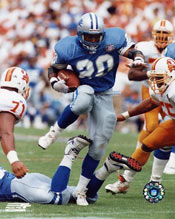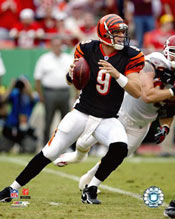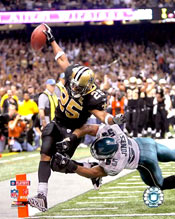
11/30/2007
Sports Channel / Bullz-Eye Home
Heisman Trophy definition: A yearly award given to the most outstanding college football player.
What it stands for: Kid, you better be good at something else, because that trophy now walks hand in hand with your doomed professional football career.
The Heisman Trophy is supposed to be the crowning achievement for a college football player. Instead, it has more recently become known as somewhat of a jinx, turning star college players into bona fide NFL busts. But does the coveted hardware really spell doom and gloom for all of its winners? Well no, not all of them. In fact, there have been plenty of college football players who won the Heisman and went on to do very good things in the NFL. Which players, you might ask? Well, you’ll have to read below to find out. We’ve listed every Heisman winner since 1984 and put them into one of two groups: studs and duds. The studs obviously took their Heisman Trophy and hit the ground running, having more than above average success in the NFL, while the duds fizzled out right after hearing the words, “And your Heisman Trophy winner is….”
Studs
1985 – Bo Jackson, RB, Auburn
Bo puts us in a tough spot since he only rushed for 2,782 yards and 18 touchdowns during his NFL career. However, consider this: Jackson racked up those numbers only playing half the time because he was also concentrating on a professional baseball career. In seven games as a rookie for the Raiders in 1987, Jackson rushed for 554 yards on just 81 carries, good for an astonishing 6.8 yard-per-carry average. He also rushed for 221 yards against the Seahawks on Monday Night Football that season, a feat that has since become a staple in NFL highlight reels. Take into account that he not only played baseball but also was actually a backup to Marcus Allen in Oakland, and Jackson’s achievements are even more impressive. If he had solely concentrated on football and hadn’t suffer a hip injury that ended his career, he had the skills to eventually become the NFL’s career rushing leader.
1986 – Vinny Testaverde, QB, Miami
Some people are going to look at this name and say, “Vinny wasn’t a stud.” First of all, to be completely accurate, someone would have to say, “Vinny isn’t a stud” since Testaverde is still playing. And yes, he is a stud. How can you deny Testaverde stud-status for playing in the NFL at age 44? And not only is he still playing, he’s actually starting! He’s been a two-time Pro Bowl selection (1996, 1998), holds an NFL record for consecutive seasons with at least one touchdown pass (21) and is the oldest quarterback to win an NFL game. He should be considered a Heisman stud based on NFL longevity alone, never mind the fact that teams still think highly enough of him to pluck him off his couch every year and declare him a starter.
1987 – Tim Brown, WR, Notre Dame
If it weren’t for some guy named Jerry Rice, Tim Brown might currently be regarded as the best wide receiver to ever play in the NFL. You want numbers? How about 1,094 career receptions (third most in NFL history), 14,934 yards (2nd), 100 touchdowns (tied for 3rd) and nine Pro Bowl appearances? He also accumulated 3,320 punt-return and 1,235 kickoff-return yards. The numbers speak for themselves, folks, and they resoundingly say: Stud!
1988 – Barry Sanders, RB, Oklahoma State
 There hasn’t been a more exciting player in NFL history than Barry Sanders. This guy was so good that he never wanted to play with a fullback because he didn’t want them getting in his way. One moment defenses would have him bottled up, the next he was sprinting down the sidelines for a 50-yard touchdown run. He finished his career with 15,269 rushing yards, a 5.0 yard-per-carry average, 99 touchdowns, a Rookie of the Year award in 1989, a co-MVP award in 1997, 10 Pro Bowl appearances and two Player of the Year awards. Had he not crushed the hearts of Lions’ fans everywhere by abruptly retiring in 1999, he probably would have eclipsed the NFL record for career rushing yards, which is currently held by Emmitt Smith.
There hasn’t been a more exciting player in NFL history than Barry Sanders. This guy was so good that he never wanted to play with a fullback because he didn’t want them getting in his way. One moment defenses would have him bottled up, the next he was sprinting down the sidelines for a 50-yard touchdown run. He finished his career with 15,269 rushing yards, a 5.0 yard-per-carry average, 99 touchdowns, a Rookie of the Year award in 1989, a co-MVP award in 1997, 10 Pro Bowl appearances and two Player of the Year awards. Had he not crushed the hearts of Lions’ fans everywhere by abruptly retiring in 1999, he probably would have eclipsed the NFL record for career rushing yards, which is currently held by Emmitt Smith.
1991 – Desmond Howard, WR, Michigan
Was Howard a dud as a wide receiver? Absolutely. But anyone who was named Super Bowl MVP gets an automatic bid into the stud category. True, any player taken fourth overall in the draft needs to be more than just a kick returner, but Howard was so good as a returner that it’s hard to refer to him as a Heisman dud. His 99-yard kickoff return for a touchdown in Super Bowl XXXI is still an NFL record.
1995 – Eddie George, RB, Ohio State
George was always the consummate professional while spending eight successful years in Houston/Tennessee. He won the Rookie of the Year award in 1996 and eventually finished his career with 10,441 rushing yards and 78 total touchdowns. He also made four Pro Bowl appearances and was one of the faces of the Oilers/Titans franchise. One of the more remarkable feats in George’s career was that he never missed a game due to injury. Considering the position he played and the brutality of the NFL, that’s quite an impressive accomplishment.
1997 – Charles Woodson, CB, Michigan
One of only three defensive players ever to be awarded the Heisman, Woodson has lived up to the hype in the NFL. Although he has often been dogged by nagging injuries and eventually developed an attitude problem with former Raiders head coach Bill Callahan, Woodson has been a solid NFL cornerback for nearly a decade. In his career, he’s totaled four Pro Bowl appearances, 358 tackles, 28 interceptions, 6.5 sacks and also won the Defensive Rookie of the Year award in 1998. When he hit the free agent market in 2006, many pundits believed that he was in the twilight of his career, but the Packers gave him a seven-year contract and thus far he’s repaid them with two quality seasons.
2002 – Carson Palmer, QB, USC
 Palmer has been everything Cincinnati Bengals fans have dreamed about since Boomer Esiason took their beloved team to two Super Bowls in the late ‘80s. Since being drafted in 2002, Palmer has appeared in two Pro Bowls (2006, 2007) and was named the FedEx Air Player of the Year in 2005. He also holds a franchise record for most touchdown passes in a season (32), passing yards in a season (4,035) and touchdown passes in a single game (six). If Steelers defensive lineman Kimo von Oelhoffen hadn’t rolled into his knee during a divisional playoff game in 2005, Palmer might have taken the Bengals to a Super Bowl that year. Maybe he’ll still get his chance, although the Bengals defense would have to stop allowing 30 points a game for that to happen.
Palmer has been everything Cincinnati Bengals fans have dreamed about since Boomer Esiason took their beloved team to two Super Bowls in the late ‘80s. Since being drafted in 2002, Palmer has appeared in two Pro Bowls (2006, 2007) and was named the FedEx Air Player of the Year in 2005. He also holds a franchise record for most touchdown passes in a season (32), passing yards in a season (4,035) and touchdown passes in a single game (six). If Steelers defensive lineman Kimo von Oelhoffen hadn’t rolled into his knee during a divisional playoff game in 2005, Palmer might have taken the Bengals to a Super Bowl that year. Maybe he’ll still get his chance, although the Bengals defense would have to stop allowing 30 points a game for that to happen.
Studud
1984 – Doug Flutie, QB, Boston College
What’s a studud? Doug Flutie is a studud – a combination of a stud and a dud. His “Hail Mary” touchdown pass against Miami was one of the greatest moments in college football history, but due to his lack of height (5’10” on a good day) NFL scouts stayed away from him come draft time. He had enormous success in the CFL, but we’re not going to hand out stud-status to someone who succeeded north of the border. However, Flutie did make one Pro Bowl appearance with the Buffalo Bills in 1998 and also won NFL Comeback Player of the Year that season. In 1999, he guided the Bills to a playoff appearance against the Titans, but head coach Wade Philips benched him for Rob Johnson and Buffalo was beat in the now famous “Music City Miracle” game. Had Flutie started his pro career in the NFL, maybe he would have achieved bigger and better things and thus found himself in the stud category. However, he has more dud than stud in him since he never really took a team to the next level as a full-time starter (see his 2001 season with the San Diego Chargers as an example). Therefore, Flutie is our lone studud.
Duds
1989 – Andre Ware, QB, Houston
In the late 1980s, the Detroit Lions ran an innovative and exciting offense that had taken the NFL by storm. The offense was called the “Run & Shoot” and was predicated on spreading the defense out by using multiple wide receiver sets and formations, as well as attacking a defense based on its tendencies. The problem for the Lions, however, was that they needed a “Run & Shoot” quarterback. It just so happened that the University of Houston had a highly successful one in 1989 named Andre Ware. Oh, it was a match made in football heaven, except not so much. Ware never grasped the nuances of the pro game and couldn’t beat out Rodney Peete and Erik Kramer for playing time. He only lasted three years in Detroit and just one more in the NFL with the Raiders before finally winding up in the CFL for two seasons.
Which is the better predictor?
The Heisman has a reputation for being awarded to great college players who turn out to be mediocre (or just plain bad) pros. It’s important to keep in mind that the Heisman doesn’t usually go to the best player in college football; it usually goes to the player that had the best season. This might explain why, from 1989 (Andre Ware) to 2003 (Jason White), only five of the 15 Heisman winners – Desmond Howard, Eddie George, Charles Woodson, Ricky Williams and Carson Palmer – went on to be named to at least one Pro Bowl.
I thought that it would be interesting to compare the Heisman to the Naismith (the award given to college basketball’s top player), to see which award was better at predicting success on the professional level. From 1990 to 2004, seven Naismith winners – Larry Johnson, Christian Laettner, Glen Robinson, Tim Duncan, Antawn Jamison, Elton Brand and Kenyon Martin – went on to make at least one All-Star appearance, so the Naismith is a bit better over the last decade and a half at predicting success in the pros.
But 15 years isn’t a big sample size, so I doubled it and included the last 30 winners of each award. I was expecting the Naismith to win this contest decisively, but there was a surprising result: they tied. Eighteen of 30 Heisman winners went on to the Pro Bowl, thanks to a remarkable 13-year run from 1976 (Tony Dorsett) to 1988 (Barry Sanders) where every Heisman winner earned a Pro Bowl nod.
This begs the question – why was the Heisman so good at predicting professional success in the 1970s and 1980s, but hasn’t been very good over the last two decades? The answer seems to lie with the forward pass.
In that golden 13-year run from ’76 to ’88, 10 running backs were chosen along with two quarterbacks (Doug Flutie and Vinny Testaverde) and one wideout (Tim Brown). Conversely, from ’89 to ’03, only four running backs won the Heisman. During that span, nine QBs were selected and only one, Carson Palmer, ever made a Pro Bowl. (By the way, four of the six non-QBs who won the Heisman went on to at least one Pro Bowl.)
It’s a given that it’s much more difficult to learn how to play quarterback in the NFL than it is to learn how to play other positions, especially running back. So, over the past several years, the tendency for the Heisman to go to a QB has caused the award to be an erratic predictor of NFL success.
But what caused this tendency? It might have something to do with the media’s obsession over the QB position. Or how Steve Spurrier pioneered his wide-open aerial attack when he became the head coach at Florida in 1990, right about the time the Heisman QB run started.
Regardless, if a quarterback wins the Heisman these days, recent history suggests he may have an uphill battle in his quest it to make the Pro Bowl.1990 – Ty Detmer, QB, BYU
Detmer is still considered one of the greatest college football quarterbacks of all time, but unfortunately for him that success didn’t translate into a great pro career. While he did find some success in the NFL (most notably with the Eagles in 1996), he was largely just a serviceable backup for many teams (six to be more specific). He gets credit for lasting 14 years in the NFL, but considering how much he achieved in college, he was a huge bust in the pros.
1992 – Gino Torretta, QB, Miami
Ah, Gino Torretta. Perhaps the biggest Heisman Trophy bust in the history of the award. Give NFL scouts credit: Torretta lasted until the seventh round of the 1993 NFL Draft because scouts knew his success would be limited to the college ranks. In four years at the University of Miami, Torretta passed for 7,000 yards. In five years in the NFL, he passed for 41. He was eventually cut a total of eight times by five different teams. Yikes.
1994 – Rashaan Salaam, RB, Colorado
To say the least, Rashaan “Fumbleitis” Salaam was a complete bust. Or should we call him, Rashaan “Fumbleitis Pothead” Salaam? Either way, the young man had a tough time hanging onto the ball and an even tougher time saying no to the reefer. He actually had a decent rookie season for the Bears in 1995, rushing for 1,074 yards and 10 touchdowns but he carried the ball about as well as Britney Spears carries her babies (11 fumbles in 1995 alone). He lasted only two years in Chicago before finishing his career with brief stops in Cleveland, Green Bay and San Francisco. The icing on the cake came in 2001 when he played in the XFL. You know things are bad when you’re receiving checks from the XFL.
1996 – Danny Wuerffel, QB, Florida
Danny “Woeful” is proof that just because a quarterback was successful in college under Steve Spurrier’s guidance doesn’t mean he’ll be productive in the NFL. He was a bit too small for the pros and it was amazing how soft he threw compared to typical NFL quarterback standards. His NFL career was a disaster and he’s often best remembered for being hit so hard by a defender that his helmet spun all the way around on his head, causing him to have to look out his ear hole as he picked himself off the ground.
1998 – Ricky Williams, RB, Texas
Where do we begin? We’ll start with the good first. After being traded by the Saints to the Dolphins in 2002, Williams rushed for 1,853 yards, made his first and only Pro Bowl appearance, and won the NFL’s MVP award. Just two seasons later, however, he tested positive for marijuana for the second time, thus facing a four-game suspension by the league. He again tested positive for the hippie lettuce in August of 2004, which made him ineligible for the entire season. Instead of cleaning himself up, he decided to retire from the game and concentrate on his real passion: smoking dope. He was recently reinstated into the NFL, but after carrying the ball just six times in a Monday Night Football game against Pittsburgh, he tore a chest muscle and was placed on injury reserve. Considering his bouts with drugs and depression and his propensity for being a weird dude, it’s easy to classify Ricky as a Heisman dud.
1999 – Ron Dayne, RB, Wisconsin
Here’s the thing about Ron Dayne: He was one of the greatest running backs in college football history. He shattered NCAA rushing records, is still renowned as the best college football player the University of Wisconsin has ever seen, and even drew comparisons to Earl Campbell coming out of college. Before you knew it, however, this strong, powerful runner in college deteriorated into a weak, marshmallow runner in the NFL. While he’s shown signs of being a productive NFL runner, Dayne just hasn’t lived up to the hype that followed him out of Wisconsin.
2000 – Chris Weinke, QB, Florida State
This stat says it all about Weinke’s NFL career: 1-15. As in, 1-15 as the starting quarterback for the Carolina Panthers in 2001. Although he did manage to be a serviceable backup toward the end of his career, Weinke’s only claim to fame was tricking the NCAA in allowing him to play college football at the age of, like, 55.
2001 – Eric Crouch, QB, Nebraska
News flash to Heisman voters: Just because a quarterback can run the option well, doesn’t mean he’s actually a good quarterback. How Crouch fooled voters into awarding him the Heisman in 2001 is beyond us. The worst part about Crouch, however, is that the guy gets an opportunity to play receiver in the NFL but decides to quit before the season starts because he’s upset that nobody gave him a chance to play quarterback. At least Andre Ware, Gino Torretta and Danny Wuerffel tried. Crouch had more pure athleticism than those three quarterbacks combined, but let his ego get in the way. Most guys would die for an opportunity to play in the NFL, yet Crouch passed on the chance because nobody wanted him as a quarterback. He should have to give his Heisman to Rex Grossman (who finished second in the voting that year) since Grossman has more guts in his left ring finger than Crouch has in his entire body.
2003 – Jason White, QB, Oklahoma
Despite his enormous success at Oklahoma (he won the Heisman as a junior), White went undrafted following his senior season in 2004 and wasn’t even given a tryout following the draft. The Chiefs eventually worked him out, but never signed him. The Titans signed him in 2005, but he wound up retiring shortly thereafter citing weak knees.
Incomplete Grades
 2004 – Matt Leinart, QB, USC
2004 – Matt Leinart, QB, USC
2005 – Reggie Bush, RB, USC
2006 – Troy Smith, QB, Ohio State
Since most football experts claim that it’s unfair to grade a player with less than three years of NFL service, we won’t do it either. Leinart, Bush and Smith get a free pass for now, but they might want to get to work considering we’ll probably revisit this feature sometime in the future. You don’t want to be caught in the dud section, do you Matt, Reggie and Troy? We didn’t think so.
Specialty Category
1993 – Charlie Ward, QB, Florida State
Ward cannot be considered a Heisman stud or dud because he is upgradeable. Upon winning the Heisman in 1993, Ward wanted to be guaranteed that he would be selected in the first round of the NFL draft. Teams didn’t want to guarantee him anything, however, because they were nervous about him bolting to the NBA, which he eventually did. Winding up in the NBA might have been a blessing in disguise considering Ward ended up having a decent basketball career. Many believed that even though he was a phenomenal athlete (he was also drafted by the Milwaukee Brewers as a pitcher in 1993), he was a bit overrated in college and would eventually fizzle in the NFL.






